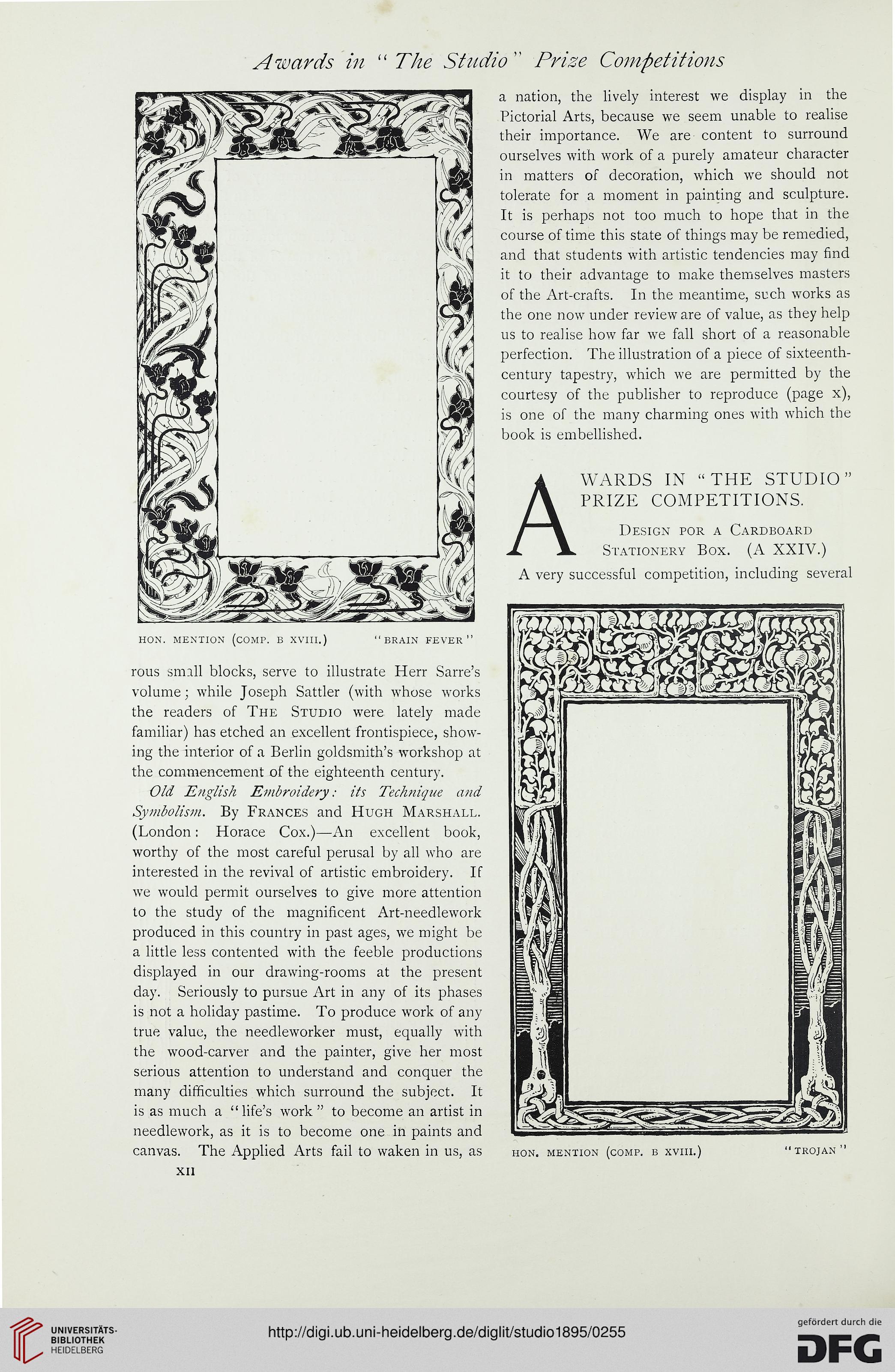Awards in 11 The Studio" Prise Competitions
a nation, the lively interest we display in the
Pictorial Arts, because we seem unable to realise
their importance. We are content to surround
ourselves with work of a purely amateur character
in matters of decoration, which we should not
tolerate for a moment in painting and sculpture.
It is perhaps not too much to hope that in the
course of time this state of things may be remedied,
and that students with artistic tendencies may find
it to their advantage to make themselves masters
of the Art-crafts. In the meantime, such works as
the one now under review are of value, as they help
us to realise how far we fall short of a reasonable
perfection. The illustration of a piece of sixteenth-
century tapestry, which we are permitted by the
courtesy of the publisher to reproduce (page x),
is one of the many charming ones with which the
book is embellished.
WARDS IN "THE STUDIO"
PRIZE COMPETITIONS.
Design por a Cardboard
Stationery Box. (A XXIV.)
A very successful competition, including several
hon. mention (comp. b xviii.) " brain fever "
rous small blocks, serve to illustrate Herr Sarre's
volume; while Joseph Sattler (with whose works
the readers of The Studio were lately made
familiar) has etched an excellent frontispiece, show-
ing the interior of a Berlin goldsmith's workshop at
the commencement of the eighteenth century.
Old English Embroidery: its Technique and
Symbolism. By Frances and Hugh Marshall.
(London: Horace Cox.)—An excellent book,
worthy of the most careful perusal by all who are
interested in the revival of artistic embroidery. If
we would permit ourselves to give more attention
to the study of the magnificent Art-needlework
produced in this country in past ages, we might be
a little less contented with the feeble productions
displayed in our drawing-rooms at the present
day. Seriously to pursue Art in any of its phases
is not a holiday pastime. To produce work of any
true value, the needleworker must, equally with
the wood-carver and the painter, give her most
serious attention to understand and conquer the
many difficulties which surround the subject. It
is as much a "life's work " to become an artist in
needlework, as it is to become one in paints and
canvas. The Applied Arts fail to waken in us, as hon. mention (comp. b xviii.) "trojan
xii
a nation, the lively interest we display in the
Pictorial Arts, because we seem unable to realise
their importance. We are content to surround
ourselves with work of a purely amateur character
in matters of decoration, which we should not
tolerate for a moment in painting and sculpture.
It is perhaps not too much to hope that in the
course of time this state of things may be remedied,
and that students with artistic tendencies may find
it to their advantage to make themselves masters
of the Art-crafts. In the meantime, such works as
the one now under review are of value, as they help
us to realise how far we fall short of a reasonable
perfection. The illustration of a piece of sixteenth-
century tapestry, which we are permitted by the
courtesy of the publisher to reproduce (page x),
is one of the many charming ones with which the
book is embellished.
WARDS IN "THE STUDIO"
PRIZE COMPETITIONS.
Design por a Cardboard
Stationery Box. (A XXIV.)
A very successful competition, including several
hon. mention (comp. b xviii.) " brain fever "
rous small blocks, serve to illustrate Herr Sarre's
volume; while Joseph Sattler (with whose works
the readers of The Studio were lately made
familiar) has etched an excellent frontispiece, show-
ing the interior of a Berlin goldsmith's workshop at
the commencement of the eighteenth century.
Old English Embroidery: its Technique and
Symbolism. By Frances and Hugh Marshall.
(London: Horace Cox.)—An excellent book,
worthy of the most careful perusal by all who are
interested in the revival of artistic embroidery. If
we would permit ourselves to give more attention
to the study of the magnificent Art-needlework
produced in this country in past ages, we might be
a little less contented with the feeble productions
displayed in our drawing-rooms at the present
day. Seriously to pursue Art in any of its phases
is not a holiday pastime. To produce work of any
true value, the needleworker must, equally with
the wood-carver and the painter, give her most
serious attention to understand and conquer the
many difficulties which surround the subject. It
is as much a "life's work " to become an artist in
needlework, as it is to become one in paints and
canvas. The Applied Arts fail to waken in us, as hon. mention (comp. b xviii.) "trojan
xii




